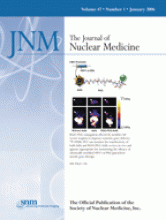Abstract
The development of noninvasive methods to visualize and quantify integrin αvβ3 expression in vivo appears to be crucial for the success of antiangiogenic therapy based on integrin antagonism. Precise documentation of integrin receptor levels will allow appropriate selection of patients who will most likely benefit from an antiintegrin treatment regimen. Imaging can also be used to provide an optimal dosage and time course for treatment based on receptor occupancy studies. In addition, imaging integrin expression will be important to evaluate antiintegrin treatment efficacy and to develop new therapeutic drugs with favorable tumor targeting and in vivo kinetics. We labeled the dimeric RGD peptide E[c(RGDyK)]2 with 18F and evaluated its tumor-targeting efficacy and pharmacokinetics of 18F-FB–E[c(RGDyK)]2 (18F-FRGD2). Methods: E[c(RGDyK)]2 was labeled with 18F by conjugation coupling with N-succinimidyl-4-18F-fluorobenzoate (18F-SFB) under a slightly basic condition. The in vivo metabolic stability of 18F-FRGD2 was determined. The diagnostic value after injection of 18F-FRGD2 was evaluated in various xenograft models by dynamic microPET followed by ex vivo quantification of tumor integrin level. Results: Starting with 18F− Kryptofix 2.2.2./K2CO3 solution, the total reaction time for 18F-FRGD2, including final high-performance liquid chromatography purification, is about 200 ± 20 min. Typical decay-corrected radiochemical yield is 23% ± 2% (n = 20). 18F-FRGD2 is metabolically stable. The binding potential extrapolated from graphical analysis of PET data and Logan plot correlates well with the receptor density measured by sodium dodecyl sulfate polyacrylamide electrophoresis and autoradiography in various xenograft models. The tumor-to-background ratio at 1 h after injection of 18F-FRGD2 also gives a good linear relationship with the tumor tissue integrin level. Conclusion: The dimeric RGD peptide tracer 18F-FRGD2, with high integrin specificity and favorable excretion profile, may be translated into the clinic for imaging integrin αvβ3 expression. The binding potential calculated from simplified tracer kinetic modeling such as the Logan plot appears to be an excellent indicator of tumor integrin density.







